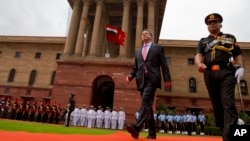India and the United States renewed a defense cooperation pact to deepen military ties during a visit by the U.S. Defense Secretary to India. A special focus will be on maritime cooperation due to mutual concerns about China’s bid to expand its naval presence.
The most significant aspect of the new 10-year U.S. India Defense Framework agreement are measures to enhance India’s defense capabilities, including co-production and co-development of military technologies.
The pact was signed late Wednesday by U.S. Defense Secretary Ashton Carter and Indian Defense Minister Manohar Parrikar.
Two projects that have grabbed attention are those in which the U.S. will help India build and design an aircraft carrier and jet engines.
As Carter wrapped up his visit Thursday, the two countries said they are expediting talks on these projects.
Jayadeva Ranade, a foreign policy expert in New Delhi, noted the aircraft carrier and jet engine technology development agreements as being particularly significant.
“Particularly I feel that the co-production and co-development of aircraft carrier technologies and jet engine technologies are strategic moves with far reaching implications and they are the ones which if they get off the ground, I think they will really be a milestone in the relationship,” said Ranade.
Carter’s visit to India included a stop at India’s eastern naval command in Visakhapatnam – the first visit by a U.S. Defense Secretary to an Indian naval base.
U.S. officials said his visit to the port showcased his commitment to maritime security, which the two countries want to enhance.
Rahul Bedi at IHS Jane’s Defense Weekly in New Delhi said that the new pact will give further momentum to the “exponential” increase in naval cooperation between the two countries in recent years. He said this is prompted by growing unease over China’s efforts to push into the Indian Ocean, through which much of its oil supplies come.
“If you look around the region, the Indian navy is a very, or is developing to be a fairly formidable force. And the problem for both India and the U.S is the expansion of the Chinese navy into the Indian Ocean region. And that is something that everybody in the region, Japan, Australia, ASEAN countries, India and the US are anxious to contain. In fact the Americans are planning to transfer a large portion of their aircraft carrier fleet to Asia over the next four, five years and it wants India very much to be a part of this rebalancing,” said Bedi.
Pointing to the aircraft carrier project, Bedi said naval cooperation between New Delhi and Washington is likely to grow in every respect, “not only in terms of exercising, but also in terms of equipment, in terms of hardware as well as in terms of joint operations.”
Indian media said that U.S. officials also reiterated their request to India to invite Japan to join a bilateral naval combat exercise they hold every year. But New Delhi has been reluctant so far as it does not want to be seen as part of an alliance.
Under the new defense pact, two small projects have been agreed upon: developing a solar generator and protective gear for soldiers against biological and chemical warfare.
As the U.S. becomes the top supplier of weapons to India, New Delhi has emphasized that it wants to co-produce weapons rather than just buy them outright.
Since Prime Minister Narendra Modi took office last year, the rocky relationship between India and the U.S. has been replaced with new energy, with both sides seeing each other as significant strategic partners.
Carter came to India after visiting Singapore and Vietnam, where he said that the U.S. military will partner with Asia Pacific nations and have a strong presence in the region.







